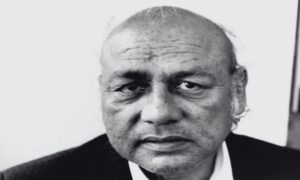Hamza Waqas
[TW: Mention of Mob Violence, Sectarian Violence]
Firaaq, directed by Nindita Das, is a political drama set in India that depicts the aftermath of the Gujarat Riots of 2002 through the eyes of ordinary citizens. . Featuring Nawazuddin Saddique, Naseeruddin Shah, Deepti Naval, Raghubir Yadav and Shahana Goswami, Firaaq came out in 2008, six years after the riots.
Multi-narrative films tend to involve multiple sets of characters, each with their own narrative, at times in a shared macro space or theme, like in ‘Salam Bombay’ (1988) for instance, ‘City of God’ (2002), ‘Gomorrah (2008)’ or even … ‘Snatch’ (2000). Firaaq presents an intricate yet delicate web of stories of people that are all in some way affected by the riots. A man returns to his home and finds that it has been burnt to the ground. Him and his wife survey the charred remains of their belongings and are overwhelmed with feelings of despair. A teacher and his apprentice try to keep their tradition of holding their weekly music lessons; one tries to keep the other in the dark about the ongoing violence for the sake of his health and general well-being. A young couple contemplates whether they should resist the growing intolerance around them or move away to a different city. The wife of an abusive Hindu-Nationalist thug, struggling to reconcile her actions in the past with her feelings of immense guilt, finds solace through powerful acts of kindness and resistance.
Firaaq depicts the aftermath of the Gujarat Riots of 2002, in which a thousand people are said to have been killed. Sadly, such shameful acts of violence tend to mirror events that have taken place much closer to home. In 1958, over the period of a few weeks dozens of members of the Ahmadiyya community were lynched in Lahore. The military had to step in and suppress the anti-Ahmadi riots and as a result martial law was imposed in Lahore for three months. Had they not intervened, the death toll might have been much higher. A larger nationwide string of violent incidents occurred in 1974, in which hundreds of innocent lives were lost. Since then countless members of the community have been killed in targeted attacks all over the country, forcing those who have survived to either flee the country or live in hiding. In 2010, simultaneous attacks on two Ahmadiyya places of worship claimed the lives of over 80 people in Lahore. Last year when I visited the city of Rabwah with a friend of mine, we were reminded of how thousands of the city’s residents still live in fear. We learnt how many of the people living in the city now, used to live in other parts of Punjab, where they no longer feel safe.
In 2013 Christian neighbourhood near Badami Bagh called Joseph Colony was attacked by a mob in Lahore. In a single day, 174 homes, 2 churches and 16 shops were burnt. The residents of the colony managed to escape after they were tipped off by the police, who failed to disperse the mob and ultimately abandoned all efforts to prevent it from entering the colony. In 2016, the Democratic Students Alliance organized an afterschool summer camp for minors at the 7th Day Adventist Church inside the colony. During our time there we had the opportunity to talk to residents about the incident and how it affected their lives in the long run. After one of our afternoon sessions, a member of the community told us that even though her family had finally saved enough to install an air conditioner in one of their rooms, they were too afraid to set it up; “kya faida hai issay idhar laganay ka, issay bhi jala dain gae.”
We need to actively resist campaigns of hate and violence. In order to do so, we must organize. Firaaq is a very powerful and thoughtful work of art that should serve as a wakeup call for citizens on both sides of the border. Both the people of Pakistan and the people of India have never seem to turn away an opportunity to instigate faith based violence against their minorities. These violent incidents that seem to occur more and more frequently must end. We must do more to defend our fellow citizens against faith based violence. As opposed to averting our eyes from the tens of thousands of protestors shouting “Shia Kafir” on the streets of Karachi earlier this year, let’s try and build alliances with oppressed communities, and resist, together! Films can be a powerful way of countering dangerous right-wing narratives and propaganda, and should be utilized by the student left in Lahore more often.
There is a need to engage with people in a meaningful, coordinated and productive way. Before we can do that, we have to start with recognizing people from these oppressed communities as people, and as equal citizens. Firaaq more than anything else humanizes a community that is consistently demonized by the religious right in India. It dispels stereotypes and generalizations about Muslims and their way of life, and depicts them in a very empathetic yet dignified way. Representations of minorities in our mainstream discourse often fail to strike that balance. Despite our good intentions, when we talk about minorities we sometimes end up saying things that are inappropriate and insensitive. There is a need for our representations of minority communities to be more thoughtful and well-informed. Whether it’s a particular phrase or our overall tone, sometimes our feelings don’t translate well on screen and in writing. Still, it’s great that some of us are writing for oppressed segments of our society. However, in addition to speaking for them we need to focus on helping them speak for themselves. We need to listen to them. We need to provide a safe and welcoming platform for the oppressed to voice their concerns and views in whichever way they see fit, and perhaps we can learn things that we hadn’t even considered before, perhaps it’ll help us improve the way we discuss oppressed communities in Pakistan in general.
As far as I know there is little to no meaningful representation of minorities in Pakistani films (save maybe … Cake 2018? Maybe? Not really…Idk). We need to work on sensitizing our audience to religious minorities. We can begin doing this by engaging with and perhaps making films about the lived experiences of people from these communities. Films which address problems faced by these communities with the attention and care that they deserve.
Firaaq (2008) is available for free on YouTube.
The Students’ Herald News Desk focuses on reporting the latest news regarding student politics and campus updates to you.
The News Desk can be reached at admin@thestudentsherald.com




